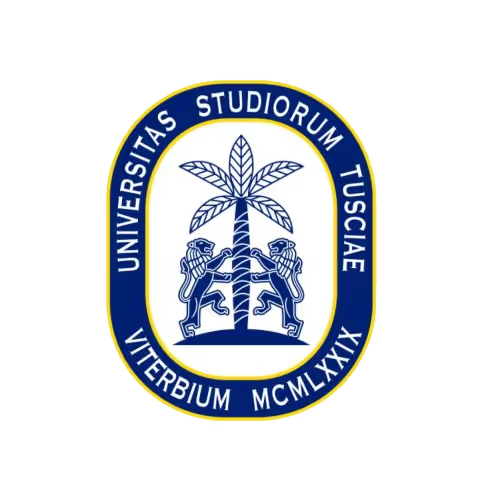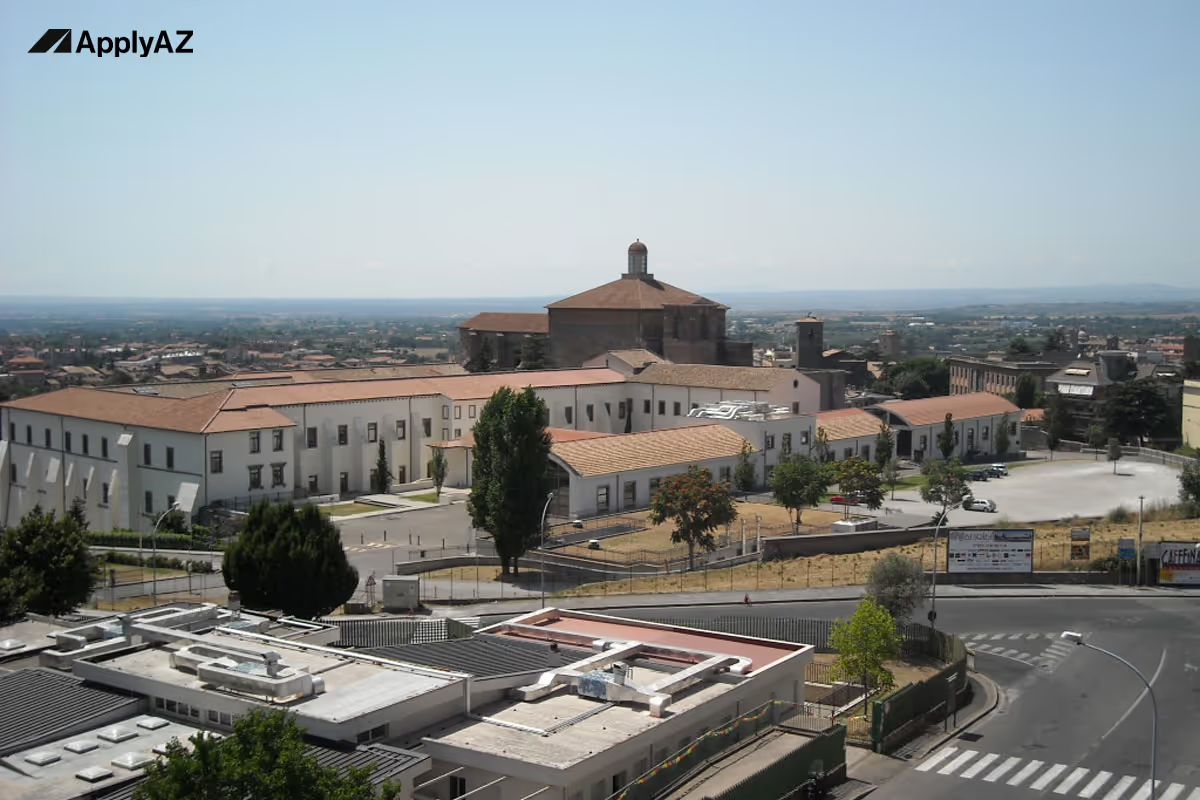Heading
Heading








University of Tuscia (Università degli Studi della Tuscia)
English-taught programs in Italy are booming, and the University of Tuscia (Università degli Studi della Tuscia) is part of that growth. Here you study in Italy in English, pay the low fees typical of tuition-free universities Italy, and enjoy the academic standards found across public Italian universities. Founded in 1979, Tuscia focuses on agri-food science, forestry, circular economy, and cultural heritage—fields that match the volcanic landscapes, Etruscan ruins, and bio-economy clusters of its home city, Viterbo.
A young public Italian university with deep local roots
Tuscia began as a network of small faculties housed in Renaissance cloisters. It now hosts six departments:
- Agriculture and Forestry Sciences
- Ecological and Biological Sciences
- Economics, Engineering, Society and Business
- Linguistics, Literature, History, Philosophy and Heritage
- Innovation in Biological, Agro-food and Forestry Systems
- Law and Social Sciences
The university ranks in the global top 400 for Agriculture and Forestry (QS 2025) and appears in the Times Higher Education Impact Rankings for Climate Action. Researchers advise FAO and UNESCO on food security and heritage conservation. With seminar groups rarely larger than 30 students, you work directly with professors on lab projects, field surveys, and peer-reviewed papers.
What you can study in Italy in English
Current English-taught degrees include:
- Circular Economy and Sustainable Tourism
- Forestry and Environmental Sciences
- Food Science and Technology
- Cultural Heritage – From Field to Digital
All follow the Bologna Process, so you can transfer credits or progress easily to European master’s programmes.
Viterbo: a medieval city that doubles as a living lab
Everyday life and affordability
Viterbo is a walled city of 65 000 residents, one hour north of Rome by train. Cobblestone lanes, natural hot-spring baths, and student cafés keep life relaxed and affordable.
- Housing: €260–350 per month for a single room in a shared flat.
- Meals: Mensa lunch costs €4.50 for pasta, salad, and fruit.
- Transport: A €20 monthly bus pass covers the city and nearby lakes.
- Climate: Winters hover around 6 °C; summers reach 30 °C but cool at night—perfect for outdoor study sessions.
Culture and leisure
- UNESCO-listed Macchina di Santa Rosa festival each September.
- Weekly farmers’ markets selling local hazelnuts and volcanic-soil vegetables.
- Romanesque churches, Etruscan tombs, and free museum nights.
Free Italian courses and tandem-language cafés help you integrate while keeping English as your study medium.
How the DSU grant helps
- Full fee waiver
- Free housing or rent allowance
- Two daily meals in canteens
- €1 700 yearly stipend for books and local travel
About 70 % of eligible applicants receive funding. ApplyAZ advisers guide you through translations, legalisations, and online forms.
Other options:
- Tuscia Merit Scholarship (€5 000) for top entrance-test scores
- Erasmus+ mobility grant (€400–500 per month)
- Ministry of Foreign Affairs scholarships for selected countries
Learning model: fieldwork, labs, and industry briefs
Hands-on classes
- Soil microbiology: collect samples in chestnut groves, analyse DNA in campus labs.
- Digital archaeology: 3-D scan Etruscan sites and build virtual tours.
- Circular-economy design: prototype bioplastic products in the FabLab.
Real-world projects
Professors embed consultancy tasks from local partners:
- Map drought risks for Acea (regional utility).
- Optimise hazelnut supply chains for Ferrero.
- Design visitor-flow dashboards for Lazio tourism board.
These projects add measurable impact to your CV.
Job and internship landscape
Key industries around Viterbo
- Agri-food and horticulture (hazelnuts, wine, olive oil)
- Forest management and biomass
- Cultural-heritage tourism and restoration
- Renewable energy (geothermal, solar)
Major employers
- ENEA Casaccia Research Centre (energy transition)
- Lazio Innova hub (agritech start-ups)
- Fiera di Roma (trade-fair organiser needing event analysts)
Non-EU students can work 20 hours weekly during term, full-time in breaks, easing living costs and building networks.
Graduate pathways
Tuscia alumni move on to:
- MSc in Plant Biotechnology at Wageningen University
- Erasmus Mundus master in Forestry Science (SUFONAMA)
- PhD in Cultural Heritage at the European University Institute
- Analyst roles at FAO headquarters in Rome
Employability stands at 88 % within one year (AlmaLaurea 2024), thanks to skills in field data, sustainability reporting, and digital heritage.
Why choose the University of Tuscia and Viterbo
- Quality teaching focused on green and heritage sectors.
- Affordable living in a historic yet student-friendly city.
- English-taught flexibility with free Italian support.
- Hands-on research that tackles climate, food security, and culture.
- Easy train link to Rome for internships and flights home.
Together they offer a balanced, inspiring, and budget-friendly route to a European degree.
In two minutes we’ll confirm whether you meet the basic entry rules for tuition-free, English-taught degrees in Italy. We’ll then quickly see if we still have space for you this month. If so, you’ll get a personalised offer. Accept it, and our experts hand-craft a shortlist of majors that fit your grades, goals, and career plans. Upload your documents once; we submit every university and scholarship application, line up multiple admission letters, and guide you through the visa process—backed by our admission-and-scholarship guarantee.
Forestry and Environmental Sciences at University of Tuscia
Italy’s forests stretch from Alpine larch to Mediterranean cork oak. Managing them demands global knowledge and local skill. The Forestry and Environmental Sciences bachelor at the University of Tuscia (Università degli Studi della Tuscia) delivers both. You will enter one of the most practical English-taught programs in Italy, live in medieval Viterbo, and pay the low fees common at tuition-free universities Italy. As part of the network of public Italian universities, Tuscia combines advanced labs, small classes, and a prime location between Rome and the Apennines, making it a smart choice for students who want to study in Italy in English and build green careers.
1 | University profile and why it matters
The University of Tuscia opened in 1979 to serve central Italy’s fertile Lazio region. Today it ranks in the top 400 worldwide for Agriculture and Forestry (QS 2025) and earns Times Higher Education Impact badges for Climate Action and Life on Land. Six departments share restored Renaissance cloisters and high-tech greenhouses. The Department of Agriculture and Forestry Sciences hosts drone fleets, DNA sequencers, and a forest-fire simulator used by EU research projects.
Professors sit on FAO panels and draft EU climate policy. Their findings flow straight into lectures, keeping you ahead of textbook curves. Small cohorts—often under thirty students—mean weekly feedback on your GIS maps or carbon-budget spreadsheets. Few public Italian universities deliver such direct professor-student contact in English.
2 | Living lab: why Viterbo is perfect for field-based learning
Viterbo is a walled city of 65 000 residents one hour north of Rome. Cobblestone streets, hot-spring baths, and chestnut woods form an outdoor classroom.
- Biodiversity – You can hike from Mediterranean scrub to beech forest in one afternoon.
- Research stations – Campus forests at Monte Rufeno and Lake Vico host long-term plots on drought and fire.
- Affordable life – Shared flats cost €260-350 per month; a student bus pass is €20.
- Culture – The UNESCO-listed Macchina di Santa Rosa parade, Romanesque churches, and free museum nights add to off-screen learning.
While you study in Italy in English, free Italian lessons and tandem cafés help you settle fast.
3 | Course structure: from core science to climate solutions
The Forestry and Environmental Sciences degree awards 180 ECTS across three years. All compulsory modules are in English; electives include Italian for fieldwork or Spanish for Erasmus.
Year 1 – Fundamentals (60 ECTS)
- General chemistry and physics for natural resources
- Botany, zoology, and biodiversity basics
- Mathematics and statistics with R
- Soil science lab—bulk density, organic carbon, and pH tests
- Introduction to geographic information systems (GIS)
Field visit: Classify vegetation zones on the slopes of a dormant volcano and compare soil moisture readings.
Year 2 – Integrated systems (60 ECTS)
- Silviculture and forest ecology
- Remote sensing using drones and Sentinel-2 imagery
- Hydrology and watershed engineering
- Forest pathology and integrated pest management
- Environmental policy and EU forest strategies
Project: Map post-fire regeneration after a summer blaze, then propose silvicultural treatments.
Year 3 – Management and innovation (60 ECTS)
- Climate-smart forestry and carbon markets
- Wildlife conservation and habitat modelling
- Bioeconomy and circular use of forest biomass
- Electives: ecological economics, mountain tourism planning, urban forestry, renewable energy in rural zones
- Six-month internship and bachelor thesis tied to an industry or research partner
Past theses: modelling climate-driven bark-beetle spread, designing agroforestry corridors for hazelnut farms, and evaluating drone-based LiDAR for biomass estimation.
Continuous assessment (lab reports, map portfolios, oral discussions) counts for half your grade, reducing end-of-semester stress.
4 | Learning methods: how theory meets practice
- Field camps – Spend ten days in the Abruzzo National Park measuring tree rings, mammal tracks, and microclimate.
- Simulation labs – Use the Wildfire Dynamics Suite to test fuel-management scenarios.
- Hackathons – Crunch Copernicus data to forecast drought‐risk hotspots.
- Stakeholder briefings – Present pest-control plans to forest-ranger corps and local farmers.
These experiences translate directly into job skills and boost your CV before graduation.
Roughly 70 % of eligible students win DSU funding. Extra options include Tuscia Merit Scholarships (€5 000), Erasmus+ mobility grants (€400-500 per month), and national scholarships for international students in Italy.
5 | Internship and career ecosystem
Local opportunities
- Forest management – Lazio regional parks hire interns to update management plans.
- Fire prevention – Drones and sensor firms need technicians to monitor canopy dryness.
- Agroforestry – Hazelnut cooperatives seek advisors to integrate tree belts and carbon credits.
- Eco-tourism – Trail associations want GIS mappers for new hiking routes.
National and EU network
Fast trains link Viterbo to Rome (80 minutes) and Florence (120 minutes). Students intern at FAO climate divisions, the European Space Agency’s Earth-Observation unit, and ENEA energy labs. Tuscia is also part of the Erasmus Forest Science network, opening placements in Finland, Spain, and Germany.
Graduate outcomes
AlmaLaurea 2024 data show 92 % employment or master’s enrolment within 12 months. Typical roles:
- Climate-smart forestry consultant
- Remote-sensing analyst for wildfire insurance
- Conservation officer in national parks
- Sustainability coordinator for timber-supply chains
Starting salaries average €30 000 inside Italy and €40 000 across northern Europe. Many graduates pursue MScs at Wageningen, Freiburg, or the Erasmus Mundus SUFONAMA consortium.
6 | Soft skills and extracurriculars
- Model UN Climate Track – Debate EU forest-carbon trading rules.
- Tree-climbing club – Train for canopy research using rope systems.
- Beekeeping lab – Manage hives on campus rooftops and analyse pollen diversity.
- Green-entrepreneurship bootcamp – Pitch start-ups to Lazio Innova investors.
Such activities build leadership, teamwork, and public-speaking abilities valued by employers worldwide.
Ready for this programme?
If you qualify and we still have a spot this month, we’ll reserve your place with ApplyAZ. Our team will tailor a set of best-fit majors—including this course—and handle every form and deadline for you. One upload, many applications, guaranteed offers, DSU grant support, and visa coaching: that’s the ApplyAZ promise. Start now and secure your spot before this month’s intake fills up.

They Began right where you are










